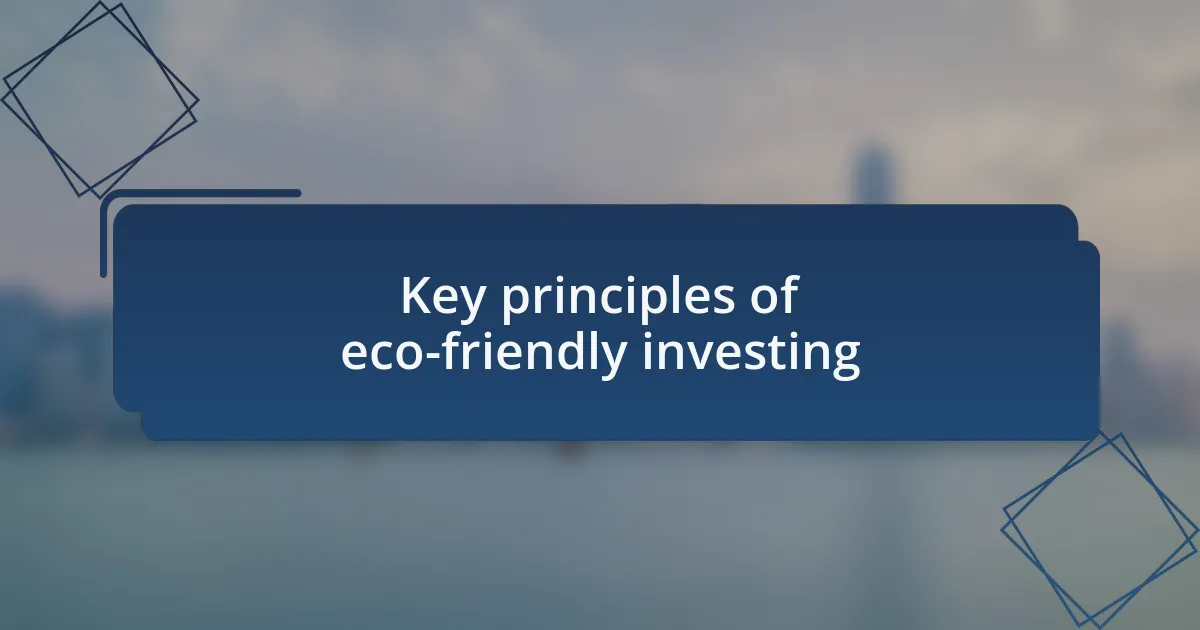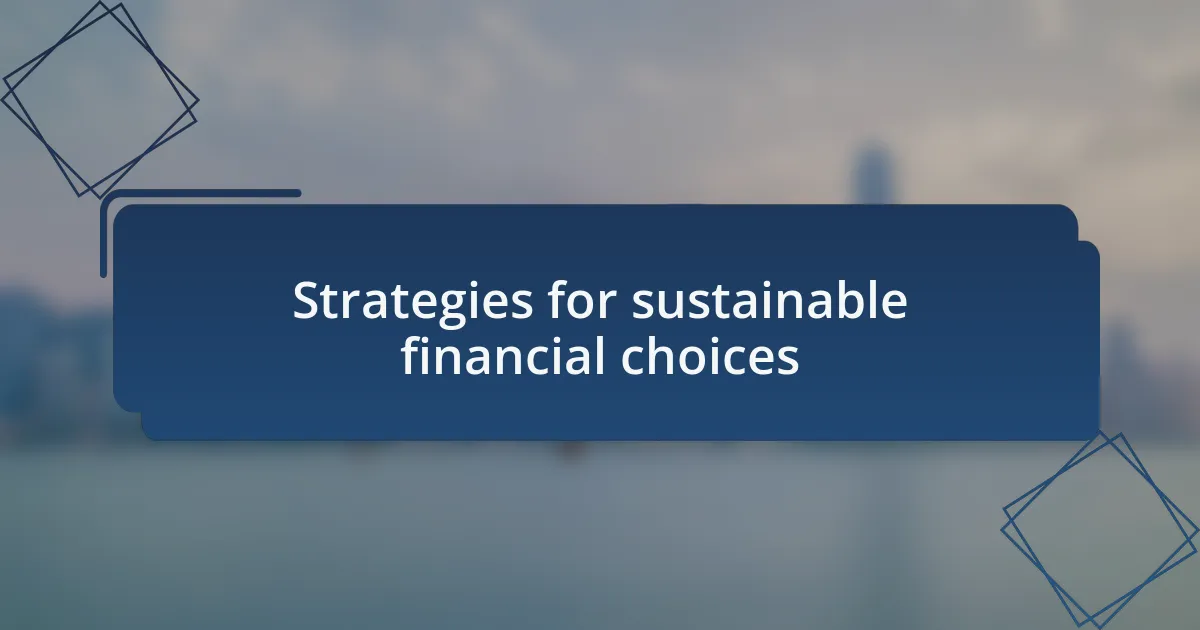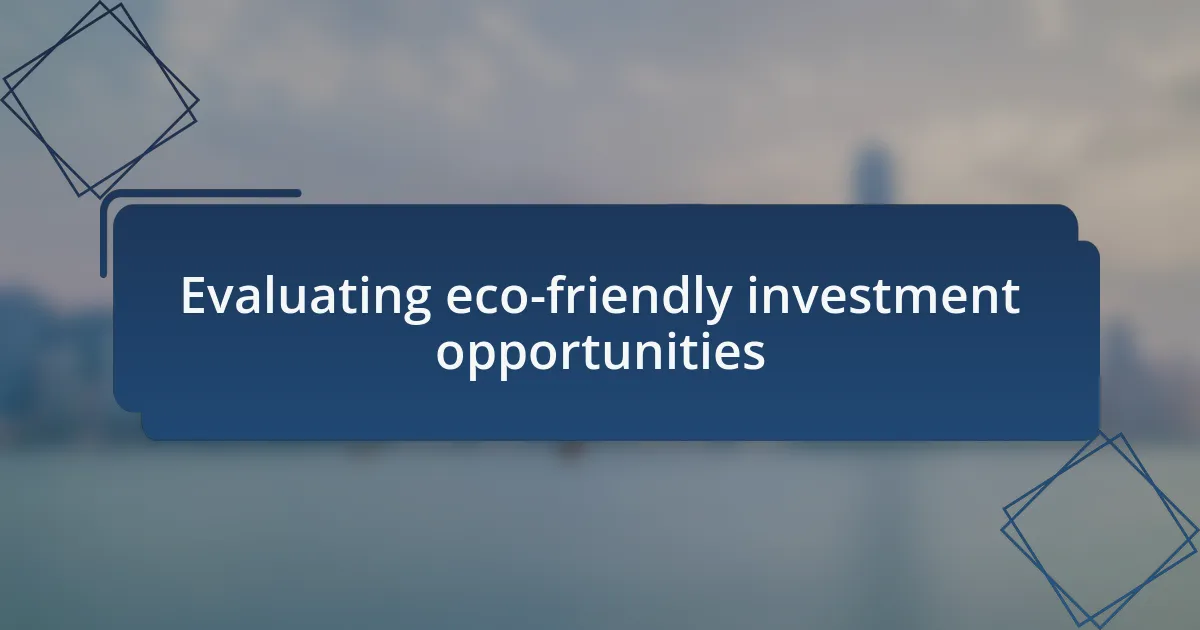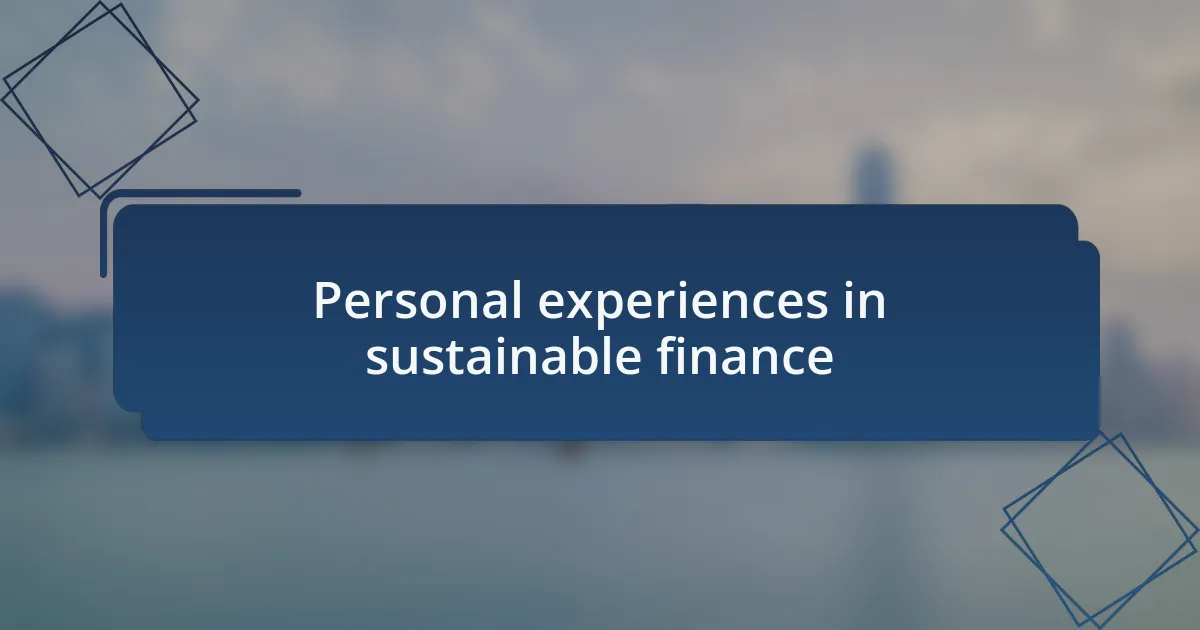Key takeaways:
- Eco-friendly finance aligns investment decisions with positive environmental impacts, supporting sustainable initiatives like renewable energy and green bonds.
- Key principles include understanding ESG criteria, demanding transparency from companies, and diversifying eco-friendly investments for both financial and environmental benefits.
- Strategies for sustainable investing involve prioritizing companies with sustainability goals, engaging with like-minded investors, and allocating funds for impact investments that generate social or environmental benefits.
- Evaluating investment opportunities requires assessing company missions, measurable environmental impacts, and recognizing the co-benefits of investing in eco-friendly companies beyond financial returns.

What is eco-friendly finance
Eco-friendly finance, at its core, aims to align financial decisions with positive environmental impacts. To me, it feels like a blend of personal values and smart investing; I ask myself how my financial choices can promote both profit and planet. For instance, investing in renewable energy companies not only supports cleaner energy but also capitalizes on a growing market trend.
When I first learned about green bonds, I was amazed by how they function to fund projects that have environmental benefits. It struck me that your investments could directly support sustainable initiatives, like wind farms or energy-efficient buildings. Isn’t it inspiring to think that your money can play a role in solving climate change?
Moreover, eco-friendly finance encompasses a broader spectrum, including ethical banking and socially responsible investing. I often ponder the question: why settle for financial returns that harm the planet? By being more conscious and intentional with our investments, I believe we can foster a healthier world while also securing our financial future.

Key principles of eco-friendly investing
Investing with sustainability in mind requires a foundational understanding of environmental, social, and governance (ESG) criteria. I remember my first encounter with ESG investing. I was skeptical at first—is it possible to achieve solid returns while focusing on ethical practices? Over time, I learned that companies scoring high on these criteria often demonstrate better long-term performance, as they’re managing risks more effectively.
Another essential principle is transparency. Companies committed to sustainability should reveal their practices and the impacts of their operations openly. I can’t help but think back to a company presentation I attended. Their commitment to reporting on carbon emissions and water usage left a lasting impression. It made me realize that we, as investors, should demand this transparency—it reflects a company’s genuine dedication to eco-friendliness.
Lastly, diversifying eco-friendly investments is crucial. As I explored various sectors—green technology, sustainable agriculture, and renewable energy—I discovered there’s strength in variety. It was eye-opening to see how diverse investments not only minimize financial risk but also amplify my contribution to a sustainable future. So, why limit ourselves to one area when the landscape of eco-friendly investing is so rich and varied?

Strategies for sustainable financial choices
One effective strategy for making sustainable financial choices is to prioritize your investment in companies that have clear sustainability goals. I recall a friend of mine who invested in a firm focused on eliminating single-use plastics. His enthusiasm was contagious; he genuinely believed in their mission. Investing in such companies can feel rewarding, as your money not only helps grow their operations but also contributes to a cause you care about.
Another approach is to stay informed about the latest developments in green finance. Engaging in discussions with like-minded investors can unveil new opportunities and insights that might otherwise go unnoticed. I remember attending a local investment meetup where we discussed emerging technologies in renewable energy. Sharing knowledge not only expanded my investment horizons but also reinforced my belief in collaborative efforts towards sustainability. Doesn’t it make sense to learn from others who share your values and are on a similar journey?
Additionally, consider setting aside a portion of your portfolio specifically for impact investments. These are investments made with the intention to generate social or environmental benefits alongside financial returns. I made this move last year, and it felt empowering. Knowing that a fraction of my savings was directly supporting a solar energy project energized my purpose as an investor. It’s about the harmony of doing well financially while doing good for the planet—who wouldn’t want that?

Evaluating eco-friendly investment opportunities
When evaluating eco-friendly investment opportunities, it’s crucial to delve into the core mission and practices of the companies you’re considering. I remember researching a startup focused on sustainable clothing; their transparency about sourcing materials and labor practices stood out to me. It became clear that investing in companies with a genuine commitment to eco-friendliness could be both a smart financial decision and a way to support ethical business practices. How can we overlook the power of voting with our dollars?
Another key aspect is to assess the measurable impact of potential investments. For instance, I once looked into a fund that quantified its carbon offset contributions, providing clear metrics on how they were improving the environment. This kind of data not only informed my decision but also assured me that my investment was genuinely contributing to sustainability. Isn’t it reassuring to know your money is making a tangible difference?
Finally, consider the co-benefits of investing in eco-friendly companies beyond just financial returns. When I invested in a renewable energy company, I discovered that they also contributed to local community projects, enhancing their social footprint. This layered approach to investment added depth to my portfolio and enriched my sense of purpose as an investor. Who wouldn’t want to feel like their investment is part of a bigger story?

Personal experiences in sustainable finance
In my journey towards sustainable finance, one experience that stands out was when I engaged with a community-supported agriculture (CSA) initiative. Investing in local farms not only allowed me to support sustainable practices but also provided me with fresh produce every week. There’s something incredibly rewarding about knowing your investment goes directly to nurturing the environment and sustaining local livelihoods.
I once attended a workshop about impact investing that changed my perspective entirely. Listening to passionate speakers share their stories about climate-focused projects sparked a sense of urgency in me. I realized that my investments could amplify my values, and it made me wonder — what if each investor saw their choices as an opportunity to drive change?
Another memorable experience was during a company Annual General Meeting, where I had the chance to engage directly with leadership. Their commitment to green innovations made it evident that they weren’t just in it for profits; they genuinely cared about our planet. It reminded me that behind every investment, there are real people dedicated to making a positive impact — a poignant realization that deepens my commitment to eco-friendly finance.